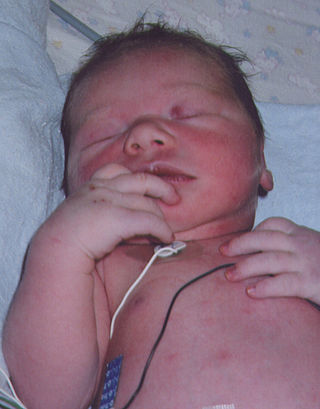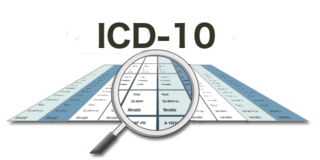Related Research Articles
The International Classification of Diseases (ICD) is a globally used diagnostic tool for epidemiology, health management and clinical purposes. The ICD is maintained by the World Health Organization (WHO), which is the directing and coordinating authority for health within the United Nations System. The ICD is originally designed as a health care classification system, providing a system of diagnostic codes for classifying diseases, including nuanced classifications of a wide variety of signs, symptoms, abnormal findings, complaints, social circumstances, and external causes of injury or disease. This system is designed to map health conditions to corresponding generic categories together with specific variations, assigning for these a designated code, up to six characters long. Thus, major categories are designed to include a set of similar diseases.
Teratology is the study of abnormalities of physiological development in organisms during their life span. It is a sub-discipline in medical genetics which focuses on the classification of congenital abnormalities in dysmorphology caused by teratogens. Teratogens are substances that may cause non-heritable birth defects via a toxic effect on an embryo or fetus. Defects include malformations, disruptions, deformations, and dysplasia that may cause stunted growth, delayed mental development, or other congenital disorders that lack structural malformations. The related term developmental toxicity includes all manifestations of abnormal development that are caused by environmental insult. The extend to which teratogens will impact an embryo is dependent on several factors, such as how long the embryo has been exposed, the stage of development the embryo was in when exposed, the genetic makeup of the embryo, and the transfer rate of the teratogen.
The diagnostic category pervasive developmental disorders (PDD), as opposed to specific developmental disorders (SDD), was a group of disorders characterized by delays in the development of multiple basic functions including socialization and communication. It was defined by the Diagnostic and Statistical Manual of Mental Disorders (DSM), and the International Classification of Diseases (ICD).

A birth defect, also known as a congenital disorder, is an abnormal condition that is present at birth regardless of its cause. Birth defects may result in disabilities that may be physical, intellectual, or developmental. The disabilities can range from mild to severe. Birth defects are divided into two main types: structural disorders in which problems are seen with the shape of a body part and functional disorders in which problems exist with how a body part works. Functional disorders include metabolic and degenerative disorders. Some birth defects include both structural and functional disorders.

Blue baby syndrome can refer to conditions that cause cyanosis, or blueness of the skin, in babies as a result of low oxygen levels in the blood. This term has traditionally been applied to cyanosis as a result of:
- Cyanotic heart disease, which is a category of congenital heart defect that results in low levels of oxygen in the blood. This can be caused by either reduced blood flow to the lungs or mixing of oxygenated and deoxygenated blood.
- Methemoglobinemia, which is a disease defined by high levels of methemoglobin in the blood. Increased levels of methemoglobin prevent oxygen from being released into the tissues and result in hypoxemia.
A medical classification is used to transform descriptions of medical diagnoses or procedures into standardized statistical code in a process known as clinical coding. Diagnosis classifications list diagnosis codes, which are used to track diseases and other health conditions, inclusive of chronic diseases such as diabetes mellitus and heart disease, and infectious diseases such as norovirus, the flu, and athlete's foot. Procedure classifications list procedure code, which are used to capture interventional data. These diagnosis and procedure codes are used by health care providers, government health programs, private health insurance companies, workers' compensation carriers, software developers, and others for a variety of applications in medicine, public health and medical informatics, including:

Fetal alcohol spectrum disorders (FASDs) are a group of conditions that can occur in a person who is exposed to alcohol as a result of their mother drinking during pregnancy. Symptoms can include an abnormal appearance, short height, low body weight, small head size, poor coordination, behavioral problems, learning difficulties, and problems with hearing and sight. Those affected are more likely to have trouble with school, the legal system, alcohol, other drugs, and other areas of high risk. The several forms of the condition are: fetal alcohol syndrome (FAS), partial fetal alcohol syndrome (pFAS), alcohol-related birth defects (ARBD), static encephalopathy, alcohol-related neurodevelopmental disorder (ARND) and neurobehavioral disorder associated with prenatal alcohol exposure (ND-PAE). As of 2016, the Swedish Agency for Health Technology Assessment and Assessment of Social Services accepted only FAS as a diagnosis, seeing the evidence as inconclusive with respect to other types.

Persistent truncus arteriosus (PTA), often referred to simply as truncus arteriosus, is a rare form of congenital heart disease that presents at birth. In this condition, the embryological structure known as the truncus arteriosus fails to properly divide into the pulmonary trunk and aorta. This results in one arterial trunk arising from the heart and providing mixed blood to the coronary arteries, pulmonary arteries, and systemic circulation. For the International Classification of Diseases (ICD-11), the International Paediatric and Congenital Cardiac Code (IPCCC) was developed to standardize the nomenclature of congenital heart disease. Under this system, English is now the official language, and persistent truncus arteriosus should properly be termed common arterial trunk.
Neurodevelopmental disorders are a group of mental disorders that affect the development of the nervous system, leading to abnormal brain function which may affect emotion, learning ability, self-control, and memory. The effects of neurodevelopmental disorders tend to last for a person's lifetime.
The International Classification of Sleep Disorders (ICSD) is "a primary diagnostic, epidemiological and coding resource for clinicians and researchers in the field of sleep and sleep medicine". The ICSD was produced by the American Academy of Sleep Medicine (AASM) in association with the European Sleep Research Society, the Japanese Society of Sleep Research, and the Latin American Sleep Society. The classification was developed as a revision and update of the Diagnostic Classification of Sleep and Arousal Disorders (DCSAD) that was produced by both the Association of Sleep Disorders Centers (ASDC) and the Association for the Psychophysiological Study of Sleep and was published in the journal Sleep in 1979. A second edition, called ICSD-2, was published by the AASM in 2005. The third edition, ICSD-3, was released by the AASM in 2014.
The classification of transsexual and gender non-conforming people into distinct groups has been attempted since the mid-1960s.

ICD-10 is the 10th revision of the International Statistical Classification of Diseases and Related Health Problems (ICD), a medical classification list by the World Health Organization (WHO). It contains codes for diseases, signs and symptoms, abnormal findings, complaints, social circumstances, and external causes of injury or diseases. Work on ICD-10 began in 1983, became endorsed by the Forty-third World Health Assembly in 1990, and was first used by member states in 1994. It was replaced by ICD-11 on January 1, 2022.

The history of chronic fatigue syndrome is thought to date back to the 19th century and before.
The ICD-11 is the eleventh revision of the International Classification of Diseases (ICD). It replaces the ICD-10 as the global standard for recording health information and causes of death. The ICD is developed and annually updated by the World Health Organization (WHO). Development of the ICD-11 started in 2007 and spanned over a decade of work, involving over 300 specialists from 55 countries divided into 30 work groups, with an additional 10,000 proposals from people all over the world. Following an alpha version in May 2011 and a beta draft in May 2012, a stable version of the ICD-11 was released on 18 June 2018, and officially endorsed by all WHO members during the 72nd World Health Assembly on 25 May 2019.
A malformative syndrome is a recognizable pattern of congenital anomalies that are known or thought to be causally related.
OPS, the Operationen- und Prozedurenschlüssel is the German modification of the International Classification of Procedures in Medicine (ICPM). For German hospitals it is currently the official coding system for medical procedures. Apart from its use for clinical controlling and performance statistics it is a basis for inpatient claims processing within the German Diagnosis-related Groups (G-DRG) system. Yearly OPS releases are produced by DIMDI. Besides OPS, G-DRG also requires disease codes based on ICD-10-GM is.

Annamarie Saarinen is an American health advocate, economist and co-founder of the Newborn Foundation, a 501(c)(3) organization that aims to accelerate the pace of early detection and intervention for treatable newborn health conditions. Saarinen also co-founded Bloom Standard, a social impact innovation lab developing early diagnostic technologies for children in remote and resource poor settings.
Cleft lip and clip palate is an "umbrella term" for a heterogeneous collection of orofacial clefts. It includes clefting of the upper lip, the maxillary alveolus, and the hard or soft palate, in various combinations. The anatomic combinations include:
The ICD-10 Clinical Modification (ICD-10-CM) is a modification of the ICD-10, authorized by the World Health Organization, used as a source for diagnosis codes in the United States of America. It replaces the earlier ICD-9-CM.
References
- ↑ "British Paediatric Association Classification of Diseases". Archives of Disease in Childhood. 54 (10): 811. doi:10.1136/adc.54.10.811-a. PMC 1545670 .
- ↑ Association, British Paediatric; Organization, World Health (May 1979). British Paediatric Association classification of diseases: successor to the Cardiff Diagnostic Classification : a paediatric supplement compatible with the ninth revision of the WHO international classification of diseases, 1977. The Association. Retrieved 23 July 2011.
- ↑ International statistical classification of diseases and related health problems: Instruction manual. World Health Organization. 1 December 2004. pp. 8–. ISBN 978-92-4-154653-9.
- ↑ "BIRTH DEFECTS AND GENETIC DISEASES BRANCH 6-DIGIT CODE : For Reportable Congenital Anomalies" (PDF). Cdc.gov. Retrieved 2 January 2015.
- ↑ "Appendix A: ICD-9 and CDC/BPA codes". Teratology. 66 Suppl 1: S218–9. 2002. doi: 10.1002/tera.90015 . PMID 12239749.
- ↑ "CDC - Birth Defects, Metropolitan Atlanta Congenital Defects Program (MACDP) - NCBDDD". Centers for Disease Control and Prevention . Retrieved 23 July 2011.
- ↑ "Appendix 5.1 : Texas Disease Index" (PDF). Nbdpn.org. Retrieved 2 January 2015.